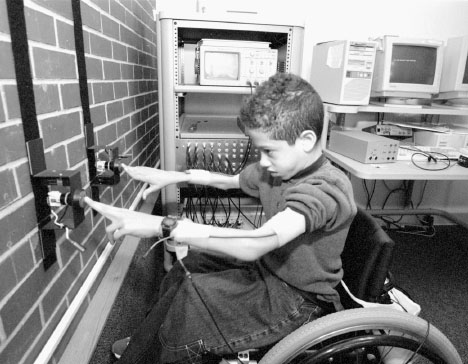The University Record, March 15, 1999
By Pat Materka
Division of Kinesiology

What happens at the molecular level to cause heart enlargement, and what does this mean for treating heart disease? What can managers do to ensure safety for spectators at sports events, and keep crowds under control?
And what can these very dissimilar research questions possibly have in common?
They both relate to “the study of human movement,” the theme that defines kinesiology and the 27 poster presentations and 12 verbal presentations featured at Kinesiology Day March 11 in the Michigan League ballroom. Some 170 faculty, staff and students took part in the sixth annual event.
Beverly Ulrich, who became director of the Division of Kinesiology in January, gave the keynote address titled “From Heart to Gait Patterns: Understanding Behavior as a Dynamic System.”
“Dynamic systems is a new approach to understanding behavior as more than the sum of its parts,” she said.
To understand behavior as dynamic system, imagine yourself on a dance floor, Ulrich said. “Think back to your first dance at age 9 or 10. Your movement patterns were influenced by who you were dancing with, the music that was playing, how you felt, what you wore.
“Today some of these same factors still affect how you behave on the dance floor, but the outcome might be quite different.” Dynamic systems analysis applies at all levels, from the cellular to the whole body, Ulrich said. She described research that approaches the heart as a dynamic system, and told how these studies are being used to design pacemakers that cause far less stress to a weakened heart. She also discussed the dynamic systems approach to her own research on human motor behavior.
“One major question underlying much of my research is where does the ability to walk come from? The traditional notion is that it is part of our genetic code, programmed in advance in some template of the brain.
“I believe walking is both self-organized and discovered. Walking, dancing and other motor behaviors are the product of multiple factors and their interaction.”
These studies have addressed basic science questions, but the goal of basic science is application, Ulrich noted, and to find ways to improve lives or the world around us. Other Kinesiology Day presentations also built on this theme, addressing such topics as the effects of treadmill training on the development of infants with Down Syndrome, walking intensity as it relates to the health of older women, and the effects of a drug called botulinum toxin on cerebral palsy patients.
Although Kinesiology Day began as a way for faculty to share information in their diverse areas of scholarship, the event also has become a showcase for student initiative. Three undergraduates, Antony Scalia, Don Packard and Julie Rahal, were among the presenters, and dozens more students were cited for their contributions to the research. Graduate and undergraduate students were first authors or collaborators on nearly all of the 27 posters. Kinesiology Day Chair Rosa Angulo-Kinzler, assistant professor of movement science, says the event is valuable from both a scientific and humanistic viewpoint.
“It opens up new venues of collaboration and reminds us of our shared mission. It is an extraordinary means for our students to gain professional experience, and an opportunity for all of us to learn from and appreciate each other.”

